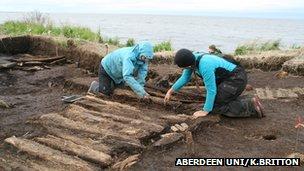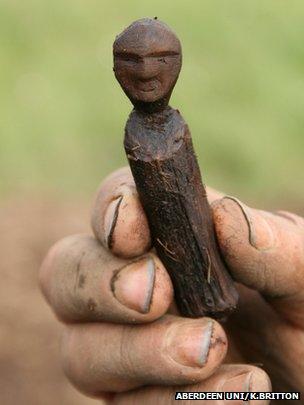Nick Crumpton
Source - http://www.bbc.co.uk/news/science-environment-19521091

The coastline is now subject to greater rates of erosion
A recently discovered 500-year-old Alaskan settlement is rapidly disappearing into the Bering Sea.
The exquisitely preserved frozen site provides a spectacular insight into the Yup'ik Eskimo culture.
Researchers from the University of Aberdeen are using isotope analyses on recovered Eskimo hair to investigate how humans adapted to rapid climate change in the Arctic village.
The research was discussed at the British Science Festival.
The Yup'ik culture was one of the last contacted Eskimo societies, but prevailed over an area three times the size of Scotland.
Although very little had been known about the archaeology of their society, a team from the University of Aberdeen was brought in to help rescue thousands of artifacts that were being eroded out of the ground near the modern village of Quinhagak.
"It's probably the most spectacularly well preserved and valuable site in terms of information content I've ever seen", Dr Rick Knecht, of the University of Aberdeen, said.
"In the first couple of years we found about 7,000 pieces, including items like ivory, woven grass, incredibly well preserved animal remains, animal fur and even human hair."
But the means by which the bounty of discoveries has been released from the soil is also the reason why the site is being eradicated.
"It's preserved by permafrost, and the permafrost is melting due to climate change. As it melts, it exposes the very soft soil to marine erosion: the shoreline retreats and the sites get damaged," explained Dr Knecht, who has been working in Alaska for more than 30 years.
"This year, we were shocked by the amount of destruction. There were artifacts as big as tables thrown up on the bank by a single storm on a high tide.

Already thousands of artefacts have been unearthed
"These storm periods are now lasting weeks longer because of the lack of ice cover. The sea ice cover is at a record low right now and continuing to drop, and every time that happens the site is at more at risk," the researcher told the BBC.
Clues from climates past
Ironically, the artifacts released by the effects of sea ice reduction may help the scientists better understand how the Yup'ik people adapted to a rapidly changing climate.
The site, known as Nunalleq, was inhabited from around AD 1350 to AD 1650, during which time the area suffered through "The Little Ice Age".
By analyzing extremely well preserved hair found at the site, the team hopes to understand how the people of Nunalleq altered their behaviour with a changing environment.
"Chemical signatures, the isotopes in your food, become present in your hair. You are what you eat," explained Dr Kate Britton, also of the University of Aberdeen.
"By analysing strands of the hair of multiple individuals, we're getting this picture of a very mixed and generalized economy incorporating salmon, caribou and other animal species.

You are what you eat: Hair samples give clues to past diets and behaviours
"This is in the earlier phase of the site and we're now working on the younger sites which will give us a clear idea of how the people's diet was adapting to changes in climatic conditions which would have affected species availability," she said.
"We can take this evidence and get an idea of what sort of changes were happening in the Bering Sea ecosystem and what sorts of changes were going on in terms of people's subsistence."
Dr Knecht added: "I think we'll be looking at a story of resilience in the face of very rapid climate change."
As the Arctic sea ice continues to decrease today, many indigenous communities are under threat from changes in the weather, but also from changes in the abundance of subsistence food stocks such as salmon and seals.
Dr Knecht underlined how important the protection of the site was for understanding both the past and how to deal with the future.
"This isn't just an area of cultural importance, but we could also create a predictive model about what to expect in the coming decades," he said.